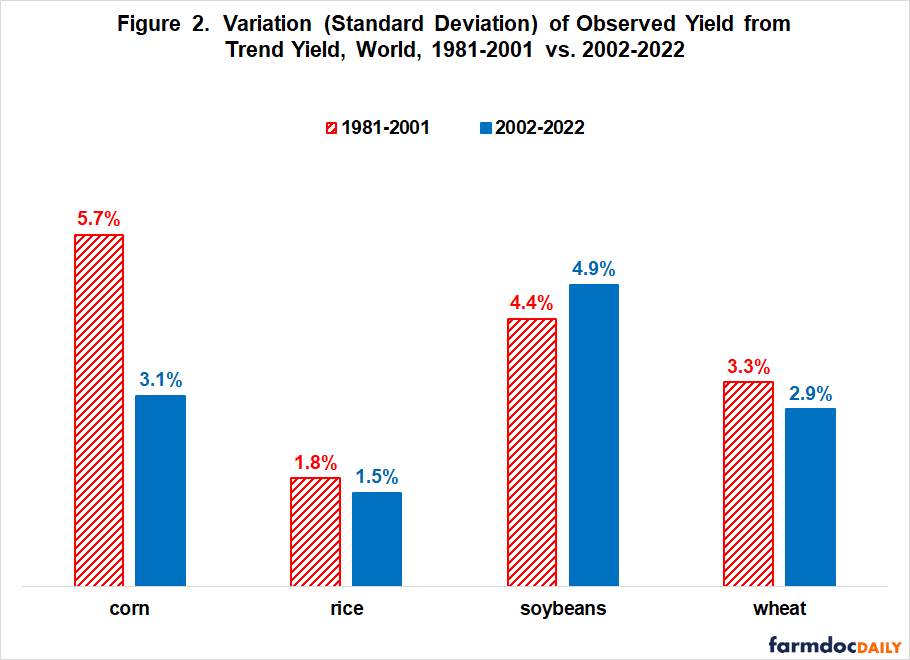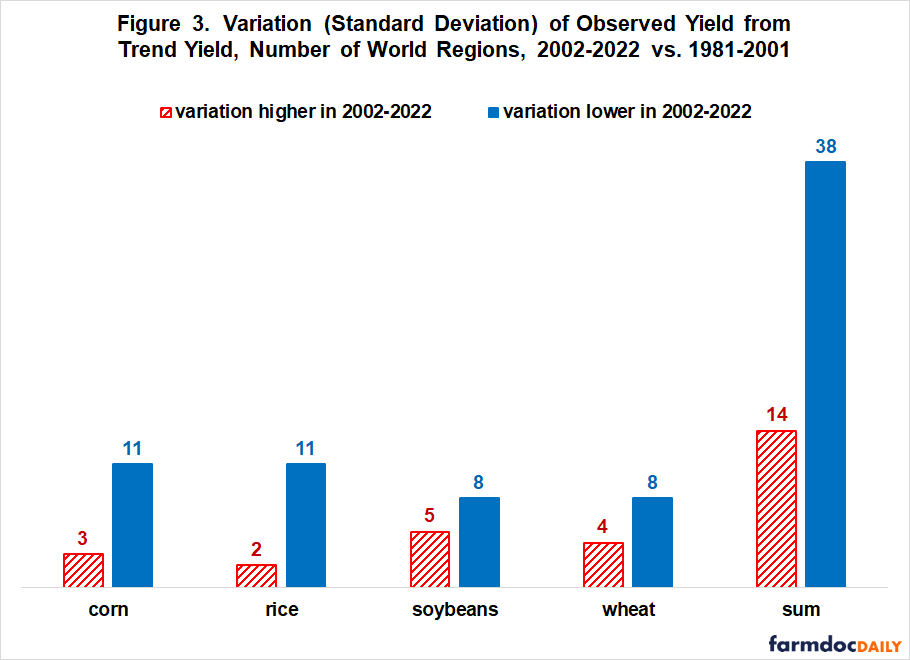Variability of World and Regional Yields in an Era of Climate Change
Increased variability of yields over time might be one negative impact of climate change on crop production. Research has found increased yield variability at the country and more micro-levels associated with climate variability. However, this analysis finds that, in general, yield variability has not increased for world and regional corn, rice, soybean, and wheat yields over 1981-2022. This finding suggests that aggregate world crop production has thus far been able to adapt to climate change impacts. The same conclusion was reached with respect to the effects of climate change on trend yield growth (see farmdoc daily, December 6, 2023). Climate change was a crucial topic discussed at COP28, the annual United Nations climate talks, held in December in Dubai.
Data
Corn, rice, soybean, and wheat yields were obtained for 1981/1982 (hereafter, the first year is used) through 2022 crop years from the Production, Supply, and Distribution Online (PSD) database (US Department of Agriculture, Foreign Agriculture Service) after the release of the November 9, 2023, World Agricultural Supply and Demand Estimates (WASDE). These crops are the world’s largest acreage grains and oilseeds. Yields were obtained for the world and 14 world regions. The regions are the Caribbean, Central America, East Asia, European Union, Former Soviet Union – 12, Middle East, North Africa, North America, Oceania, Other Europe, South America, South Asia, Southeast Asia, and Sub-Saharan Africa. A region had to have yields for all years to be included in the analysis.
Procedures
A concern is that climate change is impacting the resiliency of crop yields. Common components of the various definitions of resiliency are how quickly recovery occurs after a negative event and the ability to anticipate and minimize adverse events (see Data Note 1). The latter component is investigated in this analysis by calculating the percent deviation of observed yield from trend yield for a year. Trend yields are estimated using the time trend equations selected in the sustainability analysis discussed in farmdoc daily, December 6, 2023. Standard deviations of the percent deviations during the first half (1981-2001) and second half (2002-2022) of the analysis period are calculated. The difference in these two standard deviations is tested using an F-test (see Data Note 2).
World Yield Deviations
Figure 1 suggests that, in general, percent deviation of the observed world yield from the trend world yield by year has declined over time. This visual suggestion is consistent with a comparison of the standard deviation of percent deviations for the first and second half of the analysis period (see Figure 2). Second half standard deviation is lower for rice, wheat, and especially corn; but higher for soybeans. Only the difference for corn is statistically significant, specifically with 99% confidence. These findings suggest that the variability of world corn yields has declined while variability of world rice, soybean, and wheat yields have not changed since 1980.
Regional Yield Deviations
For 38 or 73% of the 52 crop-region combinations, the standard deviation of the yearly percent deviations of observed yield from trend yield was lower during 2002-2022 than during 1981-2001 (see Figure 3). Only three regions had two crops with a higher standard deviation during 2002-2022: Middle East (rice, wheat), Oceania (soybeans, wheat), and South America (soybeans, wheat) (see Table 1). No region had three crops with a higher standard deviation during 2002-2022. Standard deviation was higher during 2002-2022 with 95% statistical confidence only for wheat in Oceania and soybeans in South Asia. On the other hand, the F-test found that the standard deviation during 2001-2022 was lower with 95% statistical confidence for 23 crop-region combinations: 4 for wheat, 5 for soybeans, 7 for corn, and 7 for rice.
Discussion
While findings vary by crop and area, research has found evidence of negative impacts of climate change on yield variability at the country and sub-country level (see, for example, Chen, McCarl, and Schimmelpfennig, 2004, and Ray, Gerber, MacDonald, and West, 2015). However, the weight of the evidence from this analysis does not find that yield variability has increased at world and regional levels for corn, rice, soybeans, and wheat over 1981-2022. Most agree that the climate has been changing over this period, probably at an increasing rate.
The findings of this study suggest that at the world and regional levels farmers and agriculture have thus far been able to adapt. One likely adaptation factor is genetic breeding to reduce the downside variability of yields by enhancing varietal resilience to negative production pressures, including climate events (see Blum and Jordan, 1985).
Another factor enhancing world yield resiliency is the southern hemisphere’s increasing role in grain and oilseed production. Not only is variability of production in the two hemispheres uncorrelated (see farmdoc daily, July 31, 2023), but a new crop enters the market every six months or less.
This analysis does not address the impact of climate change on smaller geographical areas, such as individual countries. However, for smaller areas, the effect of climate change at regional and world levels matters if trade in agricultural products is free. Negative impacts of climate change on yield variability in one area can be mitigated by increased imports from the same or nearby regions. The role of free trade as a resiliency factor in managing the impact of higher yield variability has generally received little attention in national and international discussions. It is important to include it.
A recent non-climate illustration of world grain and oilseed adaptability is the increase in world production since the Ukraine-Russia War began (see farmdoc daily, November 27, 2023). While many have concerns about future agricultural production, the analyses discussed in this and the December 6 farmdoc daily do not support that climate change has impacted agricultural productivity and yield variability up to this point at the world and regional levels.
Data Note 1: For a readily accessible, extensive discussion of the various definitional and measurement issues surrounding the concept of resiliency see the entry in Wikipedia.
Data Note 2: The F-test assumes a normal distribution. This assumption is unlikely to hold for yield deviations. Downside yield deviations are consistently found to be larger than upside yield deviations. Despite this concern, the F-test is used because it provides a more rigorous analytical filter than comparing the levels of standard deviations. However, the results should be used with caution.
References and Data Sources
Blum, A. and W. Jordan. 1985. Breeding Crop Varieties for Stress Environments. Critical Reviews in Plant Sciences. Volume 2, Issue 3, pages 199-238.
Chen, C, B. McCarl, and D. Schimmelpfennig. 2004. Yield Variability as Influenced by Climate: A Statistical Investigation. Climatic Change. Volume 66, pages 239-261. September.
Ray, D., J. Gerber, G. MacDonald, and P. West. 2015. Climate variation explains a third of global crop yield variability. Nature Communication. Volume 6, Article number 5989. January 22.
US Department of Agriculture, Foreign Agriculture Service. November 2023. Production, Supply, and Distribution Online. https://apps.fas.usda.gov/psdonline/
Wikipedia. December 2023. Resilience. https://en.wikipedia.org/wiki/Resilience
Zulauf, C., J. Colussi, G. Schnitkey and N. Paulson,. “Comparing Variability of Southern and Northern Hemisphere Production of Corn, Soybeans, and Wheat.” farmdoc daily (13):141, Department of Agricultural and Consumer Economics, University of Illinois at Urbana-Champaign, July 31, 2023.
Zulauf, C., N. Paulson, G. Schnitkey and J. Colussi. “Resiliency in World Grain and Oilseed Production and the Ukraine-Russia War.” farmdoc daily (13):214, Department of Agricultural and Consumer Economics, University of Illinois at Urbana-Champaign, November 27, 2023.
Zulauf, C., G. Schnitkey, N. Paulson and J. Colussi. “World and Regional Trend Crop Yields in an Era of Climate Change.” farmdoc daily (13):221, Department of Agricultural and Consumer Economics, University of Illinois at Urbana-Champaign, December 6, 2023.
Disclaimer: We request all readers, electronic media and others follow our citation guidelines when re-posting articles from farmdoc daily. Guidelines are available here. The farmdoc daily website falls under University of Illinois copyright and intellectual property rights. For a detailed statement, please see the University of Illinois Copyright Information and Policies here.











